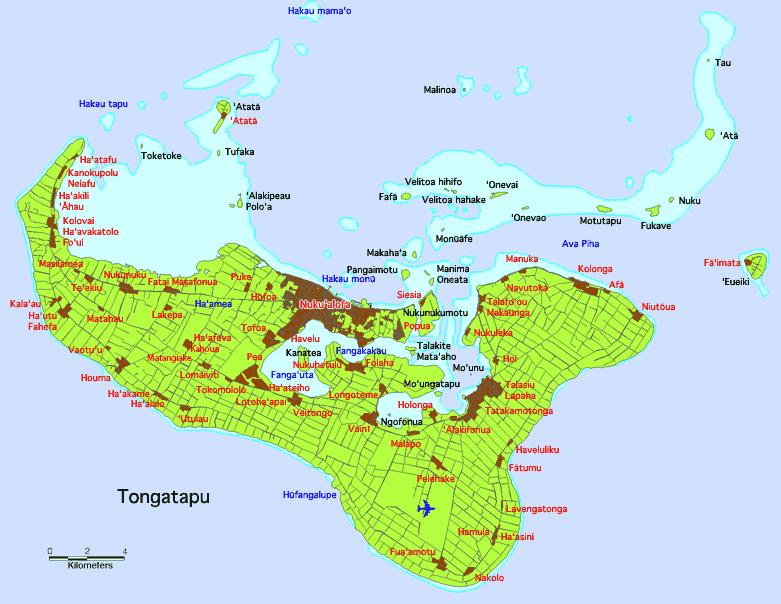|
Cyclone Cliff
Tropical Cyclone Cliff was first noted as a weak tropical disturbance on April 1, 2007, within a trough of low pressure about to the southwest of Rotuma. Over the next couple of days the system drifted towards the southeast and Fiji, in an area of strong wind shear. During April 3, the system slightly accelerated, as it moved towards the south-southeast before the westerly wind shear around the system relaxed sufficiently to allow the depression to consolidate while it was located near Vanua Levu. Early on April 4, the depression moved around the northeastern tip of Vanua Levu as bands of atmospheric convection rapidly developed and wrapped into the low level circulation center. At 0300 UTC while the system was located about to the south-southeast of Labasa, RSMC Nadi named the depression, Cliff after the system had developed into a category 1 tropical cyclone on the Australian tropical cyclone intensity scale. This was despite gale force winds not being present near the ... [...More Info...] [...Related Items...] OR: [Wikipedia] [Google] [Baidu] |
Fiji
Fiji ( , ,; fj, Viti, ; Fiji Hindi: फ़िजी, ''Fijī''), officially the Republic of Fiji, is an island country in Melanesia, part of Oceania in the South Pacific Ocean. It lies about north-northeast of New Zealand. Fiji consists of an archipelago of more than 330 islands—of which about 110 are permanently inhabited—and more than 500 islets, amounting to a total land area of about . The most outlying island group is Ono-i-Lau. About 87% of the total population of live on the two major islands, Viti Levu and Vanua Levu. About three-quarters of Fijians live on Viti Levu's coasts: either in the capital city of Suva; or in smaller urban centres such as Nadi—where tourism is the major local industry; or in Lautoka, where the sugar-cane industry is dominant. The interior of Viti Levu is sparsely inhabited because of its terrain. The majority of Fiji's islands were formed by volcanic activity starting around 150 million years ago. Some geothermal activity st ... [...More Info...] [...Related Items...] OR: [Wikipedia] [Google] [Baidu] |
Naitaba
Naitaba Island (Naitauba, Naitaba) is an island of the northern Lau Islands of Fiji. It is a triangular shaped island approximately in diameter. The island is volcanic with coral and rises to on a flat-topped hill toward the southern end of the island.United States Hydrographic Office (1916) ''Pacific Islands Pilot Volume II (Eastern Groups)'' US Navy, Government Printing Office, Washington, D.C.page 462 The island is forested and coconuts were grown commercially for copra. There is a barrier reef completely surrounding the island. History In 1965 the actor Raymond Burr and his partner purchased on the island, where they raised copra and cattle. This land was sold in 1983 to Johannine Daist Communion for the use of Adi Da Adi Da Samraj, born Franklin Albert Jones (November 3, 1939 – November 27, 2008) was an American-born spiritual teacher, writer and artist. He was the founder of a new religious movement known as Adidam. Adi Da initially became known in the ..., w ... [...More Info...] [...Related Items...] OR: [Wikipedia] [Google] [Baidu] |
2007 In Fiji
The following lists events that happened during 2007 in the Republic of Fiji. Incumbents *President: Josefa Iloilo (starting January 4) along with Frank Bainimarama *Prime Minister: Jona Senilagakali (until January 4), Frank Bainimarama (starting January 4) Events January * January 4 - Commodore Frank Bainimarama, who had carried out a military coup on 5 December, restores the deposed President Ratu Josefa Iloilo to office. * January 4 - President Iloilo appoints Bainimarama as Prime Minister of Fiji The prime minister of Fiji is the head of government of the Republic of Fiji. The prime minister is appointed under the terms of the 2013 Constitution of Fiji. The prime minister is the head of the Cabinet and appoints and dismisses ministers .... References {{Year in Oceania, 2007 Years of the 21st century in Fiji 2000s in Fiji Fiji Fiji ... [...More Info...] [...Related Items...] OR: [Wikipedia] [Google] [Baidu] |
Tropical Cyclones In Tonga
The tropics are the regions of Earth surrounding the Equator. They are defined in latitude by the Tropic of Cancer in the Northern Hemisphere at N and the Tropic of Capricorn in the Southern Hemisphere at S. The tropics are also referred to as the tropical zone and the torrid zone (see geographical zone). In terms of climate, the tropics receive sunlight that is more direct than the rest of Earth and are generally hotter and wetter as they aren't affected as much by the solar seasons. The word "tropical" sometimes refers to this sort of climate in the zone rather than to the geographical zone itself. The tropical zone includes deserts and snow-capped mountains, which are not tropical in the climatic sense. The tropics are distinguished from the other climatic and biomatic regions of Earth, which are the middle latitudes and the polar regions on either side of the equatorial zone. The tropics constitute 40% of Earth's surface area and contain 36% of Earth's landmass. , th ... [...More Info...] [...Related Items...] OR: [Wikipedia] [Google] [Baidu] |
List Of Southern Hemisphere Tropical Cyclone Seasons
{{DEFAULTSORT:Southern Hemisphere tropical cyclone seasons ...
Lists of Southern Hemisphere tropical cyclone seasons provides regional indexes to lists of articles about tropical cyclone seasons that occurred in the Southern Hemisphere. They include: *South-West Indian Ocean tropical cyclone ** South-West Indian Ocean cyclone season *Australian region tropical cyclone ** Australian region cyclone season *South Pacific tropical cyclone ** South Pacific cyclone season *South Atlantic tropical cyclone South Atlantic tropical cyclones are unusual weather events that occur in the Southern Hemisphere. Strong wind shear, which disrupts the formation of cyclones, as well as a lack of weather disturbances favorable for development in the South Atl ... [...More Info...] [...Related Items...] OR: [Wikipedia] [Google] [Baidu] |
RA V Tropical Cyclone Committee
The World Meteorological Organization (WMO) is a specialized agency of the United Nations responsible for promoting international cooperation on atmospheric science, climatology, hydrology and geophysics. The WMO originated from the International Meteorological Organization, a nongovernmental organization founded in 1873 as a forum for exchanging weather data and research. Proposals to reform the status and structure of the IMO culminated in the World Meteorological Convention of 1947, which formally established the World Meteorological Organization. The Convention entered into force on 23 March 1950, and the following year the WMO began operations as an intergovernmental organization within the UN system. The WMO is made up of 193 countries and territories, and facilitates the "free and unrestricted" exchange of data, information, and research between the respective meteorological and hydrological institutions of its members. It also collaborates with nongovernmental partners ... [...More Info...] [...Related Items...] OR: [Wikipedia] [Google] [Baidu] |
World Meteorological Organization
The World Meteorological Organization (WMO) is a specialized agency of the United Nations responsible for promoting international cooperation on atmospheric science, climatology, hydrology and geophysics. The WMO originated from the International Meteorological Organization, a nongovernmental organization founded in 1873 as a forum for exchanging weather data and research. Proposals to reform the status and structure of the IMO culminated in the World Meteorological Convention of 1947, which formally established the World Meteorological Organization. The Convention entered into force on 23 March 1950, and the following year the WMO began operations as an intergovernmental organization within the UN system. The WMO is made up of 193 countries and territories, and facilitates the "free and unrestricted" exchange of data, information, and research between the respective meteorological and hydrological institutions of its members. It also collaborates with nongovernmental part ... [...More Info...] [...Related Items...] OR: [Wikipedia] [Google] [Baidu] |
Nukuʻalofa
Nukualofa (; ) is the capital and largest city of Tonga. It is located on the north coast of the island of Tongatapu, in the country's southernmost island group. History First western records of Nukualofa On 10 June 1777, British captain James Cook wrote of his arrival at their anchorage place. His description of the place confirmed, with his map, that this was the bay of Nukualofa. Cook never used the name Nukualofa or any other spelling for the reports of this voyage, but he mentioned the island of Pangaimodoo ( Pangaimotu) which was to the east of his anchorage position. Captain Cook also wrote that he travelled by canoes to visit Mooa ( Mua) where Paulaho and other great men lived. The house that Paulaho provided was on the beach from the ship. Reference to his map shows that he must have landed and stayed in the Siesia area, the eastern part of modern Nukualofa. Cook also drafted the first map of the bay of Nukuʻalofa. The first written record for Nukuʻalofa is s ... [...More Info...] [...Related Items...] OR: [Wikipedia] [Google] [Baidu] |
Meteorological Service
Meteorology is a branch of the atmospheric sciences (which include atmospheric chemistry and physics) with a major focus on weather forecasting. The study of meteorology dates back millennia, though significant progress in meteorology did not begin until the 18th century. The 19th century saw modest progress in the field after weather observation networks were formed across broad regions. Prior attempts at Weather prediction, prediction of weather depended on historical data. It was not until after the elucidation of the laws of physics, and more particularly in the latter half of the 20th century the development of the computer (allowing for the automated solution of a great many modelling equations) that significant breakthroughs in weather forecasting were achieved. An important branch of weather forecasting is marine weather forecasting as it relates to maritime and coastal safety, in which weather effects also include atmospheric interactions with large bodies of water. Li ... [...More Info...] [...Related Items...] OR: [Wikipedia] [Google] [Baidu] |
Tongatapu
Tongatapu is the main island of Tonga and the site of its capital, Nukualofa. It is located in Tonga's southern island group, to which it gives its name, and is the country's most populous island, with 74,611 residents (2016), 70.5% of the national population, on . Based on Google Earth Pro, its maximum elevation is at least above sea level along Liku Road at 21 degrees 15 minutes and 55.7 seconds south 175 degrees 08 minutes 06.4 seconds west, but could be even higher somewhere else. Tongatapu is Tonga's centre of government and the seat of its monarchy. Tongatapu has experienced more rapid economic development than the other islands of Tonga, and has thus attracted many internal migrants from them. Geography The island is (or including neighbouring islands) and rather flat, as it is built of coral limestone. The island is covered with thick fertile soil consisting of volcanic ash from neighbouring volcanoes. At the steep coast of the south, heights reach an average of , an ... [...More Info...] [...Related Items...] OR: [Wikipedia] [Google] [Baidu] |





